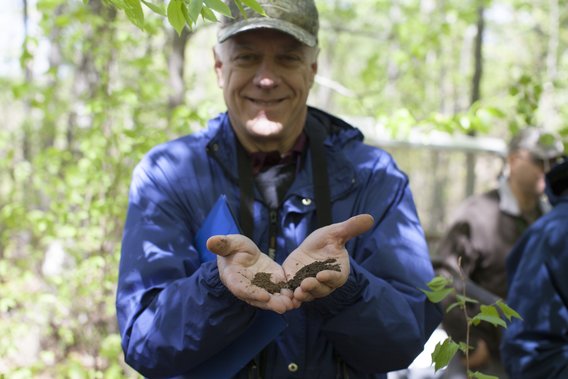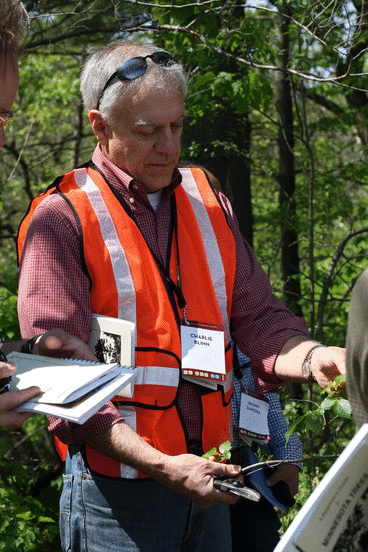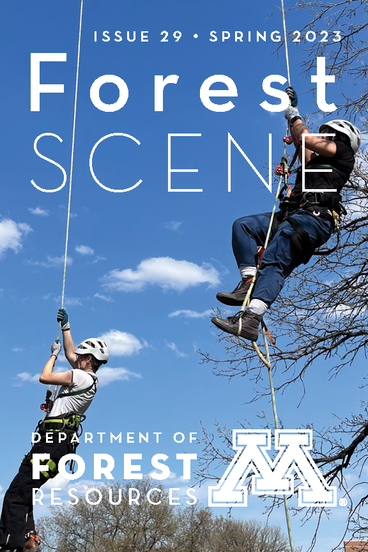
As a researcher, undergraduate professor, and University of Minnesota Extension Specialist, Charlie Blinn communicates tree science and forest management with a lot of different types of people – from undergraduates who are just learning what silviculture is to logging professionals with years of work experience. Being able to engage people of different backgrounds, familiarity with a subject, and interests is a skill honed from experience. Here, Blinn shares his approach.
As an educator, how does engaging forestry professionals differ from engaging university students?
For my introductory courses, university students generally have little knowledge about a topic yet, so we start with basic concepts and build from there. When appropriate, I also try to relate a topic to real-world applications using examples from working with professionals. Because there are few opportunities for extended-length field experiences, providing real-world examples through assignments, videos, and discussions is important.
In contrast, professional loggers and resource managers tend to have extensive knowledge and field experience already, so their classes are narrowly focused on specific topics (e.g., logging equipment capabilities and timber-sale planning). These often are face-to-face sessions with significant field time and hands-on, small-group exercises. (Unlike university students, forestry professionals often are not used to sitting in a classroom and listening to lectures.)

How is it similar?
For both groups, it’s important to focus on the topics and content which are most relevant to them.
In a classroom, discussions (small-group followed by large-group) are a good way to engage participants with the curriculum. Creating hands-on, small-group exercises, which require development of a plan, is a good way to get learners to share their ideas and perspectives.
In both groups, some participants are there only because they are required to do so (e.g., a required university course or the need to complete continuing education). Connecting the material to content of other required classes can make it more relevant to university students. Engaging professionals during breaks can help to draw them in.
What skills help you to succeed as a communicator with both groups?
With university students, it’s important to treat them with respect and to be personable. Arrive early to interact with them before class. During class, solicit questions. Importantly, connect the content to other courses within the major and draw upon real-life examples – your experiences with professionals and on-the-ground situations, for example – to connect what you’re teaching to the “real world.”
With logging and natural resource professionals, it’s also important to treat them with respect, even when they don’t agree with something and are passionate about their perspectives. Be personable and humble. Learn from and draw upon their wisdom and experiences so that knowledge can be shared. Talk with them during breaks to get to know them better. That also creates an opportunity to hear questions or important points they may have but didn’t want to ask in the classroom.
With logging professionals, never lose sight of the fact that they run businesses and are therefore profit motivated and needing to think about cost and efficiency.
Finally, be open to criticism; they may not like the message and aren’t necessarily attacking the messenger.
Learn more about U of M Extension activities related to forestry:
- Visit the U of M Extension forestry website.
- Sign up for My Minnesota Woods, a newsletter by U of M Extension's forestry team, which provides timely articles on sustainable forest management and achieving forest stewardship goals.
- Check out classes offered through the Sustainable Forests Education Cooperative and the Minnesota Logger Education Program, which involve some U of M Extension professionals.

The Forest Scene newsletter is published biannually in the spring and fall, featuring stories and updates from the Department of Forest Resources. Readers can download issue 29 of Forest Scene as an interactive PDF that is fully tagged and compatible with most screen readers, or read the individual stories here in a web-based format:
- Department Message from Kristen Nelson
- Faculty Retirement: Paul Bolstad
- ESPM Student Spotlight: Kylee Gregory
- FNRM Student Spotlight: Adam Langer
- Alumnus Spotlight: Steve Cook, Class of 1975
- Spring Semester Highlight: The Tree Ascension Club
Image 1 description: Charlie Blinn, wearing a tan baseball cap and blue jacket, holds out his hands, which are cupping some dirt. He is an older Caucasian man with white hair and a big smile.
Image 2 description: Charlie Blinn wears an orange safety vest, a plaid shirt, and jeans in the woods. He studies a low tree branch while another person takes notes beside him.
Image 3 description: Two student members of the Tree Ascension Club wearing safety gear, hanging in the air from ropes. Text reads, "Forest Scene Issue 29, Spring 2023. Department of Forest Resources." including a UMN logo.
